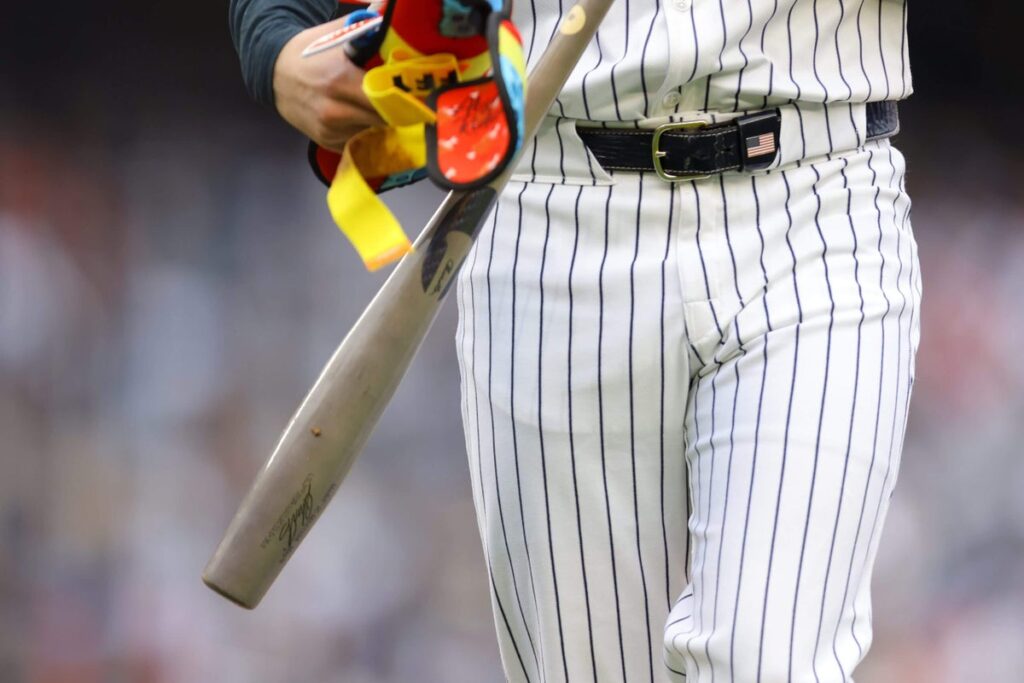
In a sport where tradition often reigns supreme, a new innovation is making waves across Major League Baseball. The New York Yankees recently captured attention with a staggering display of power, hitting a franchise-record nine home runs against the Milwaukee Brewers. This power surge has been attributed, in part, to a new type of bat known as the “torpedo bat,” designed by a former team employee and MIT physicist. The bats have sparked intrigue among players and coaches alike, including Atlanta Braves first baseman Matt Olson, a two-time All-Star known for his traditional approach.
The Yankees’ explosive performance over the weekend, which included a 20-9 victory followed by a 12-3 win, showcased the potential of these bats. YES Network announcer Michael Kay explained that the Yankees had conducted an analysis of Anthony Volpe’s at-bats, discovering that he was making more contact on the label, slightly below the barrel. This led to the creation of bats with more wood concentrated in the label area, allowing for a harder part of the bat to strike the ball.
The Science Behind Torpedo Bats
The concept of the torpedo bat is rooted in physics, aiming to maximize the sweet spot by redistributing the bat’s mass. Aaron Leanhardt, the MIT physicist behind the design, initially developed these bats while working with the Yankees’ player development team. The idea is to increase the number of “barrels” — the optimal point of contact on the bat — and reduce misses.
“His big thing was like, guys that just swing-and-miss by a fraction of an inch, you’re now fouling off, staying alive,” said Brandon Lockridge, a former Yankees minor leaguer.
Leanhardt’s approach focuses on improving contact rather than merely boosting exit velocities, a key metric in modern baseball analytics. The bats have been available to minor league players since 2022, but only recently have they gained significant attention in the majors.
Adoption Across the League
The Yankees are not alone in exploring the potential of torpedo bats. Teams like the Chicago Cubs and Minnesota Twins have also experimented with the new design. Nicky Lopez of the Los Angeles Angels, who spent spring training with the Cubs, noted that the bats are making their way around MLB.
“It’s definitely not just the Yankees. I think we’re gonna see more people — it’s legal. It’s under MLB rules and everything,” Lopez said.
While some teams, like the Boston Red Sox, have been aware of the bats, they have yet to fully integrate them into regular-season play. However, the recent performances by the Yankees have prompted a reevaluation, with more players expressing interest in trying out the new equipment.
Potential Impact and Future of Torpedo Bats
The introduction of torpedo bats could mark a significant shift in how players approach hitting. Detroit Tigers manager A.J. Hinch acknowledged the growing attention, noting that the internet has a way of turning innovations into major talking points. Meanwhile, players like Jazz Chisholm Jr. of the Miami Marlins have already experienced success with the bats, hitting home runs and doubles in early trials.
“I feel like it gives you the feeling like you have more to work with,” Chisholm said. “It gives you that extra confidence in your head to go out there and hit anything.”
Despite the enthusiasm, not all players are convinced. Some, like Aaron Judge, the reigning AL MVP, continue to rely on traditional bats, citing personal preference and the potential for pitchers to adjust their strategies. Additionally, there are those within the league who view the change with skepticism, preferring to stick with familiar equipment.
Nevertheless, the torpedo bats are legal under MLB regulations, which require bats to be smooth, round sticks not exceeding specific dimensions. As awareness and interest grow, the league may see a broader adoption of these bats, potentially altering the dynamics of hitting in baseball.
As the 2025 season progresses, the impact of torpedo bats will be closely monitored. With more players willing to experiment and adapt, the innovation could become a staple in the sport, challenging long-held traditions and offering new strategies for success.





